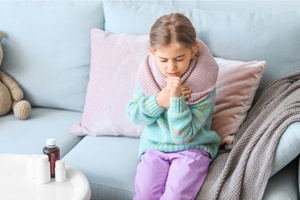
When the fall season comes around it is not uncommon for certain illnesses to spike. Many of the illnesses that peak are allergies, common colds, noroviruses, sore throats, ear infections, pink eye and the flu. It’s important to know the illnesses that thrive in fall and winter to help prevent the spread of them.
COMMON COLD
Common colds are an upper respiratory infection caused by rhinoviruses. Common colds are easily transmitted from person to person and can last anywhere from a few days to a few weeks. A common cold can affect each individual differently. However, colds are normally less severe than the flu.
Some of the symptoms of a common cold include:
- runny nose
- low-grade fever
- coughing
- sneezing
- sore throat
- headache
- congestion
ALLERGIES
There are many different triggers for allergies during the fall season. Ragweed begins to lose pollen in August and continues through September and October and can travel for hundreds of miles in the wind. Mold can also be a trigger for allergies, you don’t have to have mold in the house to be affected by mold. Mold can also live in wet spots outdoors. Dust mites are more common during the summer months but can get stirred up in the air whenever you may turn on your heater.
Some of the symptoms of allergies include:
- runny nose
- watery eyes
- itchy eyes, nose and/or throat
- sneezing
- coughing
- headache
- postnasal drainage
FLU
The flu viruses are extremely common in the autumn season. The flu, also called influenza, is an infection caused by viruses. The flu can spread easily from person to person from coughing and sneezing because they spray tiny droplets. Sometimes it is hard to tell the difference between the cold and the flu, which is why it’s important to schedule an appointment with your child’s doctor.
Some of the symptoms of the flu include:
- Fever or chills
- Sore throat
- Runny or stuffy nose
- Cough
- Muscle or body aches
- Headaches
- Fatigue
Some people also experience vomiting and diarrhea, however, this is more common in children.
NOROVIRUS
Norovirus is extremely contagious, and people can contract it through food, water or other surfaces that may be contaminated with the virus. The norovirus symptoms usually last one to three days and most can recover without any treatment. However, some people may get severely dehydrated and require medical attention.
Some of the symptoms of norovirus include:
- Nausea
- Vomiting
- Stomach pain/cramps
- Diarrhea
- Low-grade fever
STREP THROAT
Strep throat is a bacterial infection that affects the back of the neck and tonsils. Normally people feel a scratchiness or a pain in their throat during cooler weather. Strep is highly contagious even before symptoms appear. This is why it is important to have good hand hygiene and disinfect surfaces that are frequently used.
Some of the symptoms of strep throat include:
- Trouble swallowing
- Swollen lymph nodes
- Hoarse voice
- Fever
- Headache
EAR INFECTIONS
Ear infections are caused by inflammation or sometimes a virus in the middle of the ear and happen more in the fall season. Normally ear infections come after a child develops a cold or other upper respiratory illness. An acute otitis media ear infection is the most common; this is where fluid is trapped behind the eardrum and then the middle ear becomes infected and swollen.
Some of the symptoms of ear infections include:
- Fever
- Headache
- Fluid coming out of ears
- Tugging or pulling at ears
- Fussiness
CONJUCTIVITIS (PINK EYE)
The fall and winter season are also peak pink eye season, and this is more commonly found in children than adults. Kids develop pink eye from coming into direct contact with a specific viral or bacterial infection. This causes the outer eye to become swollen, redden and produce discharge. Pink eye is the most contagious when there is discharge in and around the eye.
Some of the symptoms of pink eye include:
- Redness in the white of the eyes
- Swelling of the outer eye
- Increased tear production
- Itchy or burning eyes
- Swollen lymph nodes
All of these illnesses peak during the fall and winter seasons. Make sure to schedule an appointment with your child’s doctor as soon as possible if your child begins to feel ill and show any of the above symptoms. To schedule an appointment at one of our offices, you can schedule by calling us at 281-341-9696.
Disclaimer: The contents of this article, including text and images, are for informational purposes only and do not constitute a medical service. Always seek the advice of a physician or other qualified health professional for medical advice, diagnosis, and treatment.


FOLLOW US